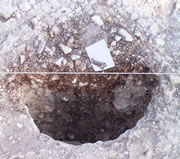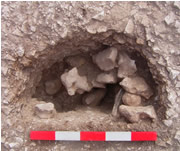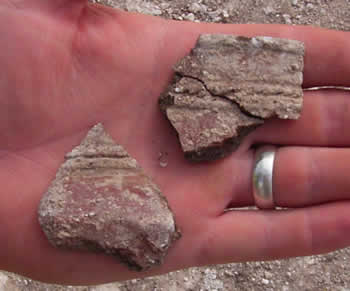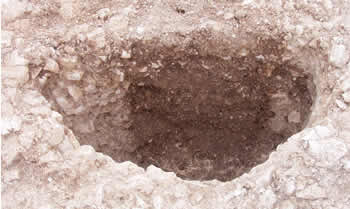
 As excavation continues on site, our knowledge about who built it, how and when, is growing. Several of the post holes that have been excavated revealed post-pipes. These occur where, in the past, a wooden post has been removed from a post hole and the resulting void has filled up with soil. The picture on the left demonstrates this: the dark vertical band is the ‘ghost’ of the post that once stood within the posthole, the lighter soil to either side of the dark patch is the original chalk packing that would have been used to keep the wooden post in place.
As excavation continues on site, our knowledge about who built it, how and when, is growing. Several of the post holes that have been excavated revealed post-pipes. These occur where, in the past, a wooden post has been removed from a post hole and the resulting void has filled up with soil. The picture on the left demonstrates this: the dark vertical band is the ‘ghost’ of the post that once stood within the posthole, the lighter soil to either side of the dark patch is the original chalk packing that would have been used to keep the wooden post in place.
Chalk, however, is not the only type of prehistoric post packing to have been used on this site. This picture shows a postpit which was uncovered on site today. You can clearly see the large flint nodules which were used in the same way as the chalk, but probably to support a much larger wooden post. Hopefully further excavation will reveal more about the type of structures or buildings these posts would have formed part of.

The most exciting discoveries of the day have been several sherds of pottery. Those shown in the picture above are the first pieces of decorated pot uncovered this season. They show the two bands of decoration around what would have been a small bowl. The style of pottery appears at first glance to be what is known as ‘All Cannings Cross’ which dates to the Early Iron Age. This confirms our belief that this site was created during the Early to Middle Iron Age (700-100 BC). Slowly but surely we are beginning to piece together the history of the site. Below is another example of a post-pipe visible within a post hole.
